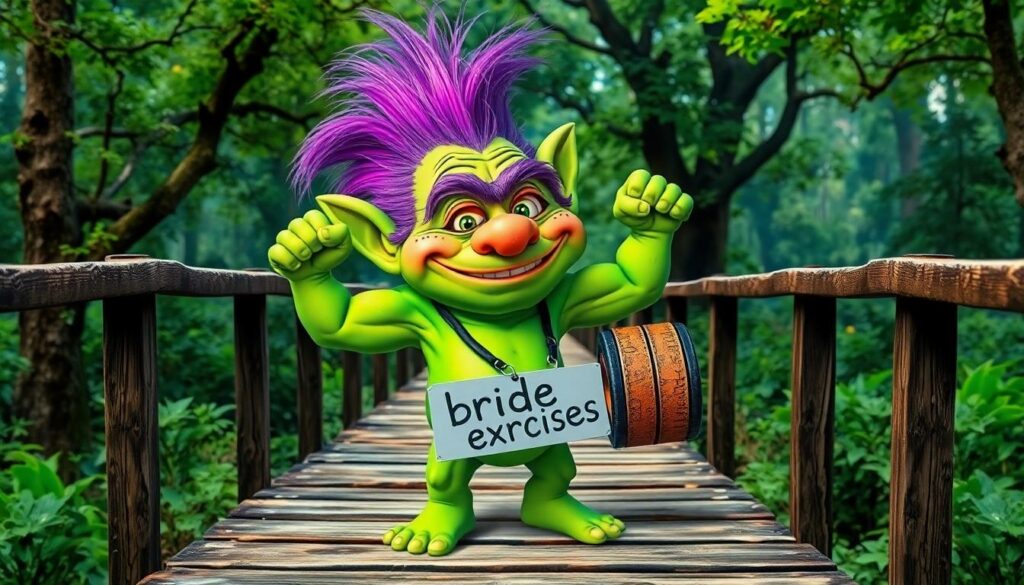Looking for some side-splitting humor that bridges the gap between fantasy and comedy? We’ve gathered the most hilarious troll puns and jokes that’ll have you rolling on the floor laughing! Whether you’re a fantasy enthusiast or simply appreciate clever wordplay, our collection has something to tickle everyone’s funny bone.
10 Hilarious Troll Puns That Will Bridge the Gap in Conversation
- What do you call a troll who lives under a bridge and loves math? A calcul-troll! These number-crunching creatures are known for their ability to solve complex equations while collecting tolls.
- Trolls make terrible secret keepers because they can’t help but bridge the subject. Whenever you share confidential information, they immediately want to connect it to something else.
- Why did the troll get fired from his bridge job? He was always trolling around! His supervisor warned him multiple times about distracting travelers with unnecessary pranks.
- What’s a troll’s favorite music? Rock and troll! These mythical creatures appreciate the heavy bass notes that vibrate their stone homes under bridges.
- How do trolls stay in shape? They do bridge-exercises! Their rigorous fitness routine includes toll collecting lunges and traveler-scaring squats.
- Why shouldn’t you argue with a troll? Because they always take things too far and bridge up old issues! Their argumentative nature makes them experts at bringing up past conflicts.
- What’s a troll’s favorite dessert? Bridge pudding! The recipe has been passed down through generations of bridge-dwelling families.
- How do trolls communicate with each other? They use a bridge-alert system! One stomp means danger, two stomps means visitors, three stomps means dinner’s ready.
- What do you call a troll who loves gardening? A hedge troll! These horticultural enthusiasts grow beautiful plant arrangements around their bridge homes.
Why Troll Jokes Are Taking Over the Internet

The Cultural Impact of Troll Humor
Troll humor has emerged as a dominant force in internet culture, reshaping how people interact online. Social media platforms have significantly amplified the reach of troll humor, allowing memes and jokes to spread rapidly across global audiences. These humorous expressions often tackle controversial topics, making them particularly effective at generating discussions and engagement online. Research connects this type of humor to exact personality traits, including sadism, Machiavellianism, psychopathy, and narcissism. Many internet users appreciate troll humor for its provocative nature and ability to challenge conventional thinking. The cultural significance of these jokes extends beyond mere entertainment, often serving as a form of social commentary that resonates with digital natives.
Why We Can’t Stop Sharing Troll Puns
Our collective fascination with troll puns stems from their unique ability to capture attention and create shared experiences. Studies show that troll humor fosters communal engagement among internet users, creating in-group feelings that strengthen online communities. Memes featuring troll puns typically spread quickly across platforms, often undergoing slight alterations that enhance their humor with each iteration. The contagious nature of trolling behavior indicates that even ordinary people can participate in sharing these jokes under the right circumstances. Research reveals an interesting paradox where individuals who enjoy sharing troll content don’t appreciate being on the receiving end themselves. Troll puns serve as cultural touchpoints that allow users to demonstrate their understanding of internet culture, creating a sense of belonging in digital spaces. The unpredictable and often subversive nature of these jokes provides a dopamine rush that keeps us coming back for more, explaining their persistent popularity across social platforms.
Classic Troll Puns That Never Get Old

Troll humor has long been cherished for its clever wordplay and absurd scenarios. These timeless jokes have been making people chuckle for generations with their unique combination of fantasy and wit.
Wordplay With “Toll” and “Troll”
The magic of troll puns often lies in the clever manipulation of similar-sounding words. “Bridge comedies” frequently top the list of favorite movie genres among trolls, creating a humorous connection between their habitat and entertainment preferences. Many trolls prefer driving a “Troll-y car” as their vehicle of choice, blending transportation terminology with troll identity. Chess enthusiasts might appreciate that trolls excel at achieving “checkmate” due to their legendary persistence. The sonic similarity between “toll” and “troll” creates endless opportunities for wordplay that keeps these jokes fresh and entertaining. We’ve found that these puns work particularly well when delivered with a straight face, allowing the listener to discover the clever wordplay on their own.
Bridge-Related Troll Humor
Bridges serve as the perfect backdrop for troll-themed humor, given their mythological significance. Trolls often explain their poor soccer performance by claiming they’re “crossed at the bridge,” turning their habitat into an excuse for athletic shortcomings. Many trolls avoid sunburn by preferring the “under the bridge shade,” making light of their traditional dwelling place. “Gravel-flavored chips” frequently appear as the snack of choice at troll gatherings, connecting their rocky environment to modern convenience foods. Block parties rank as trolls’ favorite social events, creating a clever construction-themed pun. Hide-and-seek games present challenges for trolls who can’t resist “peeking under the bridge,” turning their habitual behavior into a humorous disadvantage. These bridge-centered jokes effectively blend mythical characteristics with everyday situations, creating relatable humor that stands the test of time.
Troll Jokes for Different Occasions

Special Occasions
Trolls don’t just live under bridges—they celebrate life’s milestones too! When attending a wedding, try this heartfelt toast: “Taking the ultimate leap—may you cross the bridge together, forever!” Birthday celebrations call for a playful “Another year older? Time to troll yourself a birthday cake!” For graduates achieving academic success, acknowledge their accomplishment with “Congrats! You’ve surpassed troll-level knowledge—bridge engineer when?” During Thanksgiving, invite guests to “feast like trolls after collecting tolls.” Valentine’s Day becomes extra special when you suggest to “Troll over to a romantic bridge dinner.” As the New Year approaches, remember the classic warning: “Don’t feed the trolls!”
Holiday Themes
Seasonal celebrations deserve special troll treatment! During Halloween, set the spooky mood with “Don’t be scared under the bridge tonight!” Christmas transforms into “Merry Trollmas” with the festive wish “May your bridges stay safe and sturdy!” These holiday-themed troll jokes bring mythical charm to traditional celebrations.
Family-Friendly Troll Puns
Kids and parents alike will enjoy these clean troll jokes! Why don’t trolls ever play hide-and-seek? They always come out from under the bridge! Dessert time becomes more fun when you ask about a troll’s favorite treat: Rocky road ice cream! Sports fans will chuckle when you explain why trolls are bad at soccer—they always get crossed at the bridge! Sun protection isn’t a concern for these creatures because they always stay under the bridge shade.
Office-Appropriate Troll Humor
Workplace banter benefits from light-hearted troll humor that keeps things professional yet fun. Ask colleagues about a troll’s favorite vehicle: A troll-y car! These office-friendly jokes can lighten serious conversations, fostering camaraderie among team members. Internet trolls often use humor to ease tension in discussions, a technique that translates well to workplace settings by creating friendly competition and stronger team bonds.
How to Craft Your Own Troll Puns

Creating your own troll puns doesn’t require magical powers – just a bit of creativity and wordplay. We’ve compiled expert techniques to help you create puns that will have everyone groaning and laughing in equal measure.
Create Scenarios Requiring Logical Leaps
Troll puns work best when they create unexpected connections between ideas. Start by identifying words with multiple meanings related to trolls or bridges. For example, combine “patrol” with “troll” to create a joke about “pa-trolling” under bridges. These logical leaps surprise your audience and create that perfect punchline moment that makes puns memorable.
Developing scenarios that require your audience to make sudden mental connections enhances the humor significantly. Try setting up a normal situation, then introduce a troll-related twist that forces the listener to reconsider the entire premise from a new angle.
Use Phonetics for Unique Sounds
Playing with similar-sounding words creates the foundation for excellent troll puns. Words like “toll,” “stroll,” and “control” naturally lend themselves to troll-themed wordplay. The pronunciation similarities create amusing effects when substituted in familiar phrases or contexts.
Experimenting with alliteration can also amplify your pun’s impact. Phrases like “tremendously troublesome trolls” roll off the tongue and add an extra layer of humor through their sound patterns.
Juggle Meaning for Playful Discoveries
The best troll puns often operate on multiple levels of meaning. Try taking common phrases and inserting troll-related terms to create new interpretations. “Bridge the gap” becomes “troll the gap” with just one substitution, creating a playful discovery for your audience.
Exploring different interpretations of words related to traditional troll mythology can yield surprisingly humorous insights. Consider how terms like “bridge toll” might have a completely different meaning in a industry where trolls collect payments.
Tailor Puns to Platforms
Different social media platforms favor different types of humor. Visual puns work well on Instagram and Pinterest, while quick wordplay thrives on Twitter. On Facebook, longer narrative puns with a setup and punchline tend to perform better.
Adapting your pun style to match the platform increases engagement and sharing potential. For TikTok, consider how your pun might work as part of a visual skit, while on Reddit, puns that reference community-exact content often gain the most traction.
Essential Elements of a Good Troll Joke
A truly effective troll joke contains several key elements that elevate it from merely amusing to genuinely memorable:
Surprise Elements: The most successful troll jokes incorporate unexpected turns or punchlines. Setting up one expectation then delivering something completely different creates that moment of surprise that triggers laughter. For instance, starting with a conventional bridge story but ending with a twist about toll collection methods.
Interactivity: Great troll jokes often encourage responses, creating a chain of humor. Crafting your joke to invite others to build upon it creates an ongoing exchange that amplifies the fun. Asking a question like “What do you call a troll who loves math?” invites others to attempt answers before you deliver your “calcul-troll” punchline.
Visual Incorporation: Adding images or visual elements can significantly enhance troll humor. A simple sketch of a troll at a toll booth or under a bridge can provide context and strengthen the punchline. These visuals create additional layers of meaning that complement your wordplay.
Common Wordplay Techniques
Master these fundamental wordplay techniques to create puns worthy of any bridge-dwelling trickster:
Homophones and Homographs: Words that sound alike (homophones) or are spelled the same but have different meanings (homographs) form the backbone of great troll puns. Pairing “troll” with similar-sounding words like “stroll,” “toll,” or “roll” creates instant wordplay opportunities. For example, “The troll couldn’t pay the toll, so he had to take out a loan.”
Puns on Current Events: Connecting your troll jokes to contemporary issues or popular memes makes them more relatable and shareable. If a bridge construction project is in the news, jokes about trolls facing housing disruptions will resonate with local audiences.
Playful Language: Incorporating onomatopoeias (like “grumble” or “stomp”) or alliteration enhances the lighthearted effect of troll puns. These language techniques create rhythm and make your puns more memorable. A joke about “terribly tired trolls trudging toward troubled travelers” uses alliteration to add linguistic flair to the humor.
Troll Puns in Popular Culture

Troll puns have become a staple in online humor, blending mischievous wordplay with absurdity to create uniquely entertaining content. These puns thrive in digital spaces where the line between harmless jokes and subversive humor often blurs.
Famous Movie and TV Show References
Popular media has embraced troll characters that inspire countless puns and jokes. The Shrek franchise portrays ogres with troll-like qualities that have generated wordplay across fan communities. Harry Potter‘s infamous bridge-dwelling trolls have also spawned chess-related humor about making “troll moves” or romantic “pun-der-the-stars” campfire jokes. We’ve seen these characters become cultural touchstones that lend themselves naturally to punny interpretations. Their exaggerated physical traits and behaviors provide perfect fodder for creative wordplay that resonates with audiences familiar with these beloved franchises.
Troll Humor in Children’s Entertainment
Children’s media has transformed traditional troll imagery into family-friendly content perfect for pun-filled storytelling. The Trolls animated films (2016 and beyond) reimagine these creatures as colorful, singing characters who love nothing more than expressing joy. Kids particularly enjoy innocent troll wordplay like “Why do trolls love fishing? They enjoy a good line!” These more wholesome interpretations contrast sharply with internet trolling culture. Family entertainment typically focuses on the playful aspects of troll mythology rather than their mischievous tendencies. DreamWorks and other studios have successfully capitalized on the whimsical potential of troll characters, creating merchandising empires built partly on the appeal of their pun-friendly nature and bright, captivating personalities that captivate young audiences.
Troll Jokes That Are So Bad They’re Good

The Art of the Groan-Worthy Troll Pun
Troll puns have been noted for their remarkable ability to induce simultaneous groans and laughter from their audience. Crafting these puns requires clever wordplay that walks the line between amusing and cringe-worthy. Research shows that the most effective troll jokes often use phrases like “troll-lette” when referring to cake or describe punny discussions as “pun-derful” [1]. The true artistry lies in creating connections between unrelated concepts, much like asking why the troll went to therapy—because it had a lot of bridges to cross [1]. These deliberate word manipulations trigger our brain’s pleasure centers while also making us want to roll our eyes, creating that perfect balance of delight and despair that defines the groan-worthy troll pun.
When Bad Jokes Become Legendary
Some troll jokes transcend their “bad joke” status to become legendary fixtures in our collective humor. These jokes often gain traction because they highlight unexpected correlations, like the spurious relationship between the ‘trollface’ meme popularity and funeral attendance in Alabama [5]. Social media has amplified these jokes, allowing them to spread rapidly across platforms and embed themselves in internet culture. The most legendary troll jokes often incorporate bridges as central elements, playing on the traditional habitat of mythological trolls while linking to modern contexts. Humor bridges even the most disparate topics, proving that sometimes a joke can leave someone literally “unable to get over it” [1]. The enduring nature of these jokes speaks to our fascination with wordplay that’s simultaneously terrible and brilliant—comedy that’s both dying to be analyzed and analyzed to death.
Digital Trolling vs. Troll Puns: Understanding the Difference

Digital trolling represents the deliberate act of upsetting or annoying people online through provocative or misleading messages. These actions aren’t meant to be humorous but rather aim to cause irritation among internet users. Many online platforms have implemented strict policies against this behavior as it can lead to harmful interactions and negative online experiences.
Troll puns, conversely, are lighthearted jokes that leverage the concept of mythical trolls to create amusing wordplay and funny situations. These humorous expressions don’t intend to upset anyone but instead bring joy through clever linguistic connections. For example, jokes like “Why did the troll start a fashion line? Because he loved trolling the runway!” demonstrate the playful nature of troll puns.
Key Differences
Intent serves as the primary distinguishing factor between these concepts. Digital trolling specifically aims to provoke negative emotions or upset others, while troll puns are created purely for entertainment and amusement. This fundamental difference shapes how audiences receive and respond to each type of content.
Content style varies significantly between the two approaches. Digital trolling typically involves spiteful or misleading information designed to trigger reactions, whereas troll puns use clever wordplay and light humor like “What’s a troll’s favorite cake? A troll-lette!” The contrast in content reflects their divergent purposes in online communication.
Context plays a crucial role in differentiating these concepts as well. Digital trolling occurs exclusively in online environments and often carries harmful implications for those targeted. Troll puns appear in casual humor settings and maintain a non-malicious tone that welcomes everyone to participate in the joke rather than making anyone the subject of mockery.
The Psychological Benefits of Sharing Silly Troll Jokes

Neurochemical Effects
Sharing troll jokes triggers important dopamine release in our brains, improving our mood while simultaneously reducing cortisol levels that cause stress. The absurdity found in troll jokes amplifies these effects by cleverly subverting our expectations, creating a stronger neurological response than conventional humor. Laughter from these jokes stimulates multiple organs and activates stress-relief pathways in our bodies. Research shows that the unexpected punchlines in troll humor create a neurochemical reaction that serves as a natural mood enhancer.
Social Bonding
Troll jokes strengthen our relationships by fostering perceived similarity and signaling alignment in worldviews between people who share the laugh. The exaggerated silliness characteristic of troll humor creates moments of mutual amusement that significantly enhance group cohesion. Studies indicate that when we laugh together at the same absurd bridge-dwelling puns, we experience greater interpersonal satisfaction and connection. Our brains register this shared mirth as evidence of compatibility, making troll jokes powerful tools for social connection.
Emotional Regulation
Laughter from silly troll jokes helps temper excessive anxiety and hostile emotions by providing a healthy outlet for tension. These jokes offer a harmless, exaggerated target for lighthearted critique without creating actual conflict. Many people find that captivating with deliberately silly troll puns provides emotional distance from stressors. The deliberate absurdity gives us permission to momentarily step away from serious concerns and gain perspective through humor.
Enhanced Communication
Troll jokes serve as excellent social lubricants that reduce relational friction in everyday interactions. Collaborative laughter during troll-like banter improves cooperation and team dynamics in both professional and personal settings. Many workplace teams report better problem-solving capabilities after sharing moments of humor. The playful language patterns in troll jokes open channels of communication that might otherwise remain closed in more formal exchanges.
Stress Relief Mechanisms
Our bodies experience measurable cortisol reduction and endorphin release during laughter triggered by good troll jokes. This biochemical combination effectively counterbalances our stress responses and creates feelings of wellbeing. Scientific measurements show these effects can last for hours after the initial laughter subsides. Regular exposure to humor, including silly troll jokes, builds resilience against future stressors by training our bodies to access these relief pathways more readily.
Social Signaling Benefits
Shared troll jokes act as powerful “social glue” that reinforces in-group identity and builds trust between individuals. When we exchange these jokes, we signal acceptance and understanding of shared cultural references. Groups that regularly share humor show higher levels of cohesion and loyalty. The inside jokes that evolve from troll humor create lasting social bonds that strengthen communities both online and offline.
Cognitive Shift Advantages
The absurdity in troll humor disrupts negative thought patterns by forcing our minds onto unexpected tracks. This cognitive shift offers mental respite from rumination and worry cycles that might otherwise dominate our thinking. Psychologists note that even brief exposures to nonsensical humor create measurable improvements in cognitive flexibility. Troll jokes, with their playful exaggeration and irony, are particularly effective at creating these beneficial mental detours.
Conclusion: Why We’ll Never Get Over the Bridge of Troll Humor
We’ve traveled under the bridge and back exploring the industry of troll humor where puns lurk around every corner. These jokes connect us through shared groans laughter and eye-rolls while offering surprising psychological benefits.
Whether you’re crafting your own troll wordplay sharing classics on social media or using them to lighten the workplace mood these puns have secured their place in our cultural industry.
So next time you encounter a troll joke remember there’s more happening than meets the eye. They’re not just silly plays on words but bridges that connect us creating communities and bringing joy to our digital lives. We’ll keep crossing that bridge for years to come!
Frequently Asked Questions
What are troll puns?
Troll puns are humorous jokes that play on the word “troll” and related concepts from fantasy folklore, often combining wordplay with absurd scenarios. They typically involve bridges, mythical creatures, and clever manipulation of similar-sounding words. These puns create comedy by blending traditional troll mythology with everyday situations.
How are troll puns different from internet trolling?
Troll puns are lighthearted jokes designed to entertain through wordplay and humor, while internet trolling aims to provoke negative reactions through misleading or inflammatory content. The key differences lie in intent (entertainment vs. provocation), tone (playful vs. confrontational), and social context (inviting shared laughter vs. creating discord).
Why are bridges so common in troll jokes?
Bridges are central to troll jokes because of the traditional folklore association between trolls and bridges, where trolls would live under bridges and demand tolls from travelers. This classic imagery provides rich material for wordplay between “toll” and “troll,” creating a foundation for countless puns about bridge-dwelling, tolls, and “under the bridge” scenarios.
What makes a good troll pun?
A good troll pun combines unexpected wordplay, relatable scenarios, and a balance between cleverness and absurdity. The most effective troll jokes create surprise through logical leaps, use homophones creatively, incorporate visual elements, and deliver with perfect timing. The best ones often elicit both groans and laughs simultaneously.
How can I create my own troll puns?
Create your own troll puns by playing with words that sound like “troll” (toll, stroll, control), incorporating bridge references, mixing troll mythology with everyday situations, and experimenting with unexpected connections. Focus on phonetics, multiple meanings, and scenarios that require logical leaps. Test your jokes with friends to refine your wordplay.
Why do people enjoy sharing troll jokes on social media?
People enjoy sharing troll jokes on social media because they create communal engagement, provide a dopamine rush, and foster a sense of belonging in digital spaces. Sharing these jokes builds social connections through shared humor, offers stress relief through laughter, and allows for creative self-expression. They’re also highly shareable due to their brevity and universal appeal.
Are there family-friendly troll puns?
Yes, many troll puns are family-friendly and suitable for all ages. These typically focus on wordplay, silly scenarios, and mythological elements rather than offensive content. Family-friendly troll jokes often feature playful scenarios like trolls doing everyday activities, bridge-related humor, and punny situations that children can understand and enjoy.
How have troll characters evolved in popular culture?
Troll characters have evolved from frightening creatures in Nordic folklore to diverse representations in modern media. Traditional scary bridge-dwellers have transformed into colorful, joyful characters in children’s entertainment like the Trolls franchise, while maintaining mischievous elements in fantasy works like Harry Potter. This evolution reflects changing cultural attitudes toward mythological creatures.
What are the psychological benefits of sharing troll jokes?
Sharing troll jokes provides neurochemical benefits by triggering endorphin and dopamine release, reducing stress hormones, and creating social bonds through shared laughter. These jokes offer emotional regulation through cognitive shifts away from negative thinking, strengthen group identity, and provide a form of adaptive humor that helps people cope with life’s challenges.
Why do some troll puns become “legendary” online?
Troll puns become legendary online when they perfectly balance cleverness with absurdity, connect seemingly unrelated concepts in surprising ways, and resonate with shared cultural references. These standout jokes typically gain traction through viral sharing, create “aha” moments of recognition, and often incorporate bridges or other troll mythology in unexpectedly brilliant ways.







